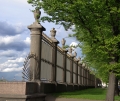Virtual sightseeing tour of the center of St. Petersburg
38 photo with description16.05.2020 10:51
16.05.2020 10:51
Andrey Panevin

Since we are in self-isolation and we are all sitting at home, then a small virtual sightseeing tour of the center of St. Petersburg. We will start our journey from the Anichkov Bridge.
Anichkov Bridge is one of the most beautiful bridges in St. Petersburg .
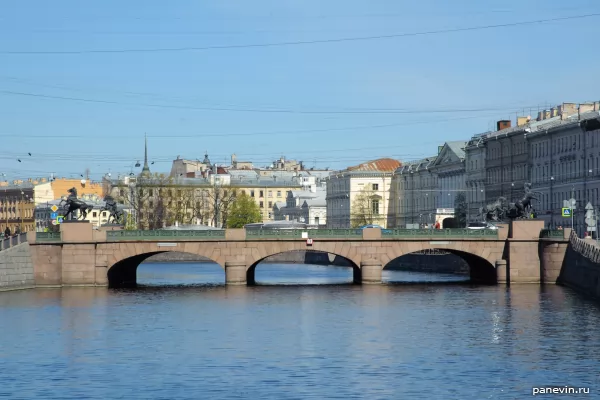
The first bridge across the Fontanka along Nevsky Prospect was made of wood and was built by soldiers of the battalion of Lieutenant Colonel-Engineer Mikhail Anichkov, which is why the name of the bridge came from. In 1715, Peter I ordered to build a bridge on this place, which was done by May 1716 . The first bridges at this place were drawbridge so that sailing ships could pass without folding their masts. The current three-span stone bridge was opened to traffic on November 20 1841, and in 1851 the bridge received its main decoration, which became one of the symbols of St. Petersburg - the sculptural composition "The taming of a horse by a man." 4 youths and 4 horses, which is why the people of the bridge received the comic name “The Bridge of 16 Eggs”. However, before the revolution there was a joke among the townspeople: "How many eggs are there on the Anichkov Bridge?" Because bridges have always been strategic objects, then a policeman was on duty at each, so any St. Petersburg resident answered with confidence: "eighteen!"
- A talented citizen relieves his needs in Fontanka, a policeman approaches and makes a remark.
- What, counts are allowed, but proletarians are not allowed? And he points to the bewildered law enforcement officer to the inscription on the pedestal of one of the figures: "Cast count Klodt".
Separate note: Anichkov bridge...
Nameless Erik began to be called Fontanka, probably because of the fountains of the Summer Garden, destroyed by one of the devastating floods of the 1720s and recently restored.

Gostiny Dvor is a vivid example of classicism in a purely utilitarian building. This typical building and similar guest houses were in other parts of the city, for example, on Vasilievsky Island. It is worth noting that the first Gostiny Dvor was slightly to the right and a couple of noticeable fragments of walls remained from it - from the side of Nevsky Prospekt and from Lomonosov Street. The building of the former Duma, pay attention to the hexagonal superstructure above the tower - this is an optical telegraph. Some of the ones I know of have survived at the Winter Palace and on the building of the Technological Institute. In the 1820s and 1830s, optical telegraph stations connected the capital with the suburbs and built a line to Warsaw. Since the 1850s, the need for an optical telegraph has disappeared, after the invention of the electric one. Nevsky Prospect

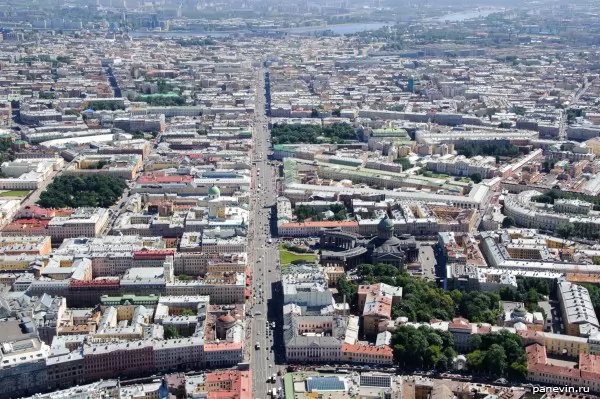
Nevsky Prospect - the main transport artery of St. Petersburg. Nevsky after Vosstaniya square turns a little and this part is still called Staro-Nevsky by the townspeople. The name of the avenue has no direct relation to the Neva, Nevsky is named after the Alexander Nevsky Lavra, and that, in turn, is nicknamed Alexander Nevsky. Those. there is a connection with the Neva, but it is not direct.
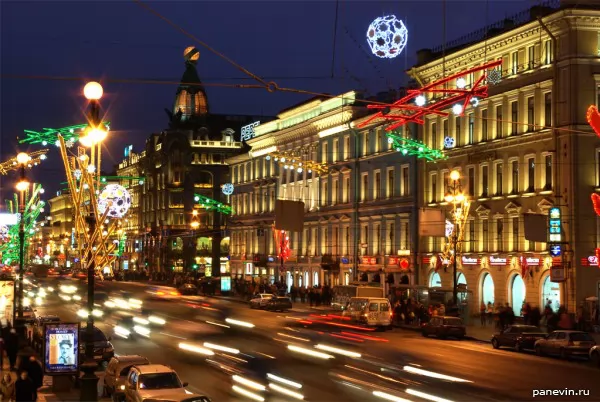
The house of the Singer company, one of the most notable buildings on Nevsky Prospect. But now tourists leaving the metro to the embankment of the Griboyedov Canal first of all take pictures of the building with an attractive turret, and at the time of construction the townspeople were outraged that modernity and eclecticism does not fit into the surrounding buildings. The presence of a turret indicates that the city had high-rise regulations ( Nicholas I issued a decree according to which it was impossible to build higher than the Winter Palace ), but the customer really wanted to stand out from the rest of the buildings and the architect designed such a turret. The Bolsheviks, as part of the fight against two-headed eagles on the facades of buildings, did not understand birds very much and destroyed the American coat of arms on this building. The bald eagle was restored only in the 90s. Before the revolution, the
Griboyedov Canal was the Catherine Canal, and before the foundation of the city it was the Krivusha River.
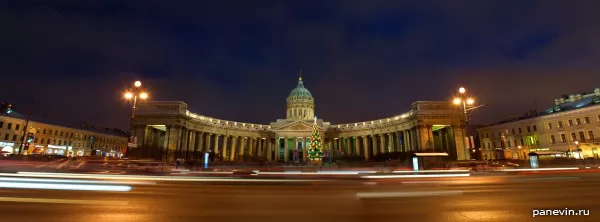
Kazan Cathedral - Voronikhin's architectural masterpiece... The fact is that according to the canons of the construction of Orthodox churches, the cathedral stands sideways to Nevsky Prospekt, but due to the colonnade, it seems that the cathedral is facing the avenue. The completion of construction coincided with the end of the war of 1812 and the cathedral became a pantheon of war heroes, trophy French banners were placed here and Field Marshal Kutuzov was buried . In front of the cathedral there are bronze sculptures of Kutuzov and Barclay de Tolly. If you look from Kutuzov towards Barclay, the scroll in the general's hand looks like a phallus. As if the commanders want "in a small way," and Kutuzov with a scroll indicates where the nearest tavern with a toilet was.
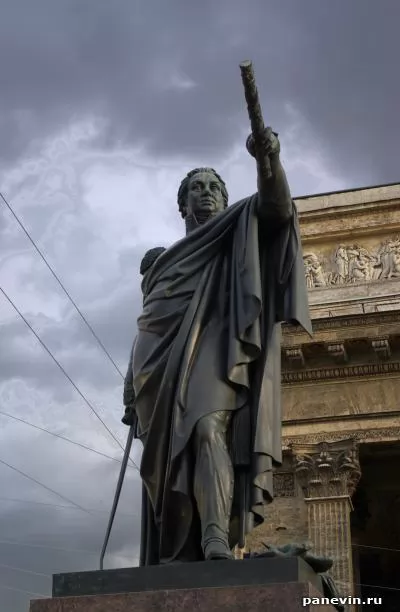
But seriously, there is a legend that the Leningraders believed that as long as the commanders stood intact, the city would not be taken. Unlike the Bronze Horseman and the monument to Lenin at the Finlyandsky railway station, these monuments were not hidden during the blockade (like the monument to Suvorov at the Troitsky bridge ). Monument to Catherine II on Ostrovsky Square. Where is such a lady, Behind which is the drama, On the Left is enlightenment, On the Right is entertainment, And in the front is not available to everyone? Behind the monument is a drama theater, on the left is the Public Library, on the right is the Rest Garden, and in front is the Eliseevsky store, the prices of goods in which at all times were not available to everyone.
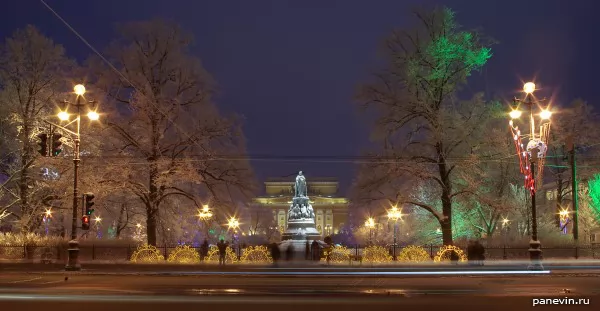
Catherine II on Ostrovsky Square.
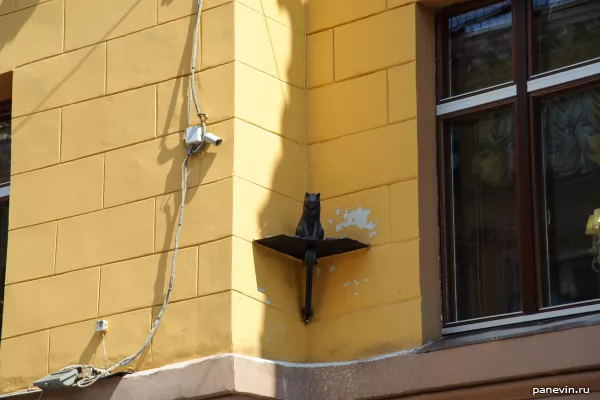
On Malaya Sadovaya Street, there are two remarkable monuments - Siberian and Ural cats, which were transferred by echelons to besieged Leningrad by order of the Supreme Command Headquarters. Two small monuments are dedicated to these cats - the cat Arseny and the cat Vasilisa.
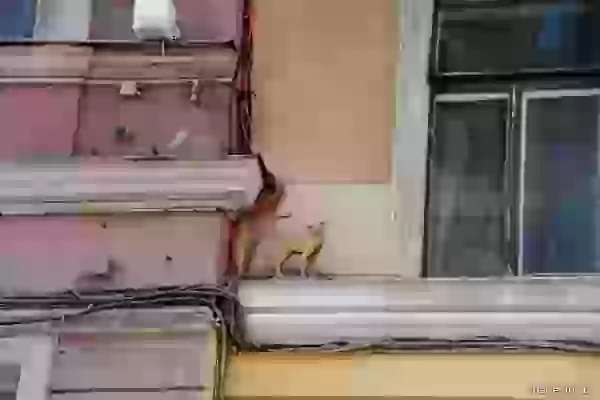
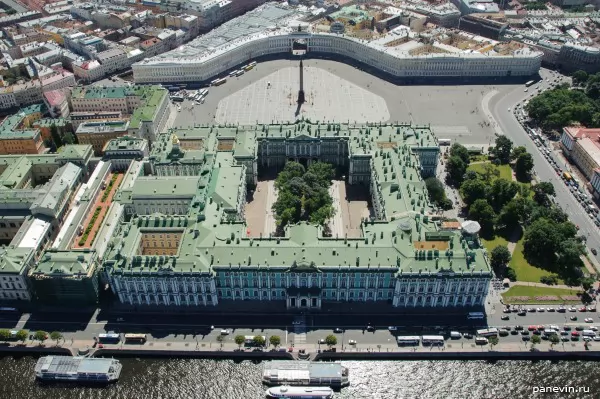
Palace Square - the Winter Palace (architect FB Rastrelli ), the General Staff Building (architect K. I. Rossi), the Alexander Column (architect O. Montferrand ), one of the most beautiful architectural ensembles in the world. The square received its completed appearance after the construction of the General Staff building and the installation of the Alexander Column. “Since the work was carried out in the winter, I ordered to mix cement with vodka and add a tenth of soap
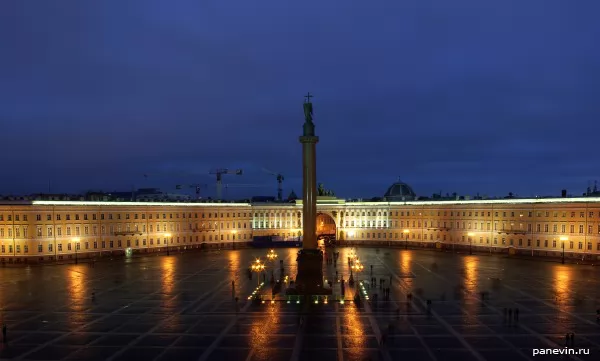
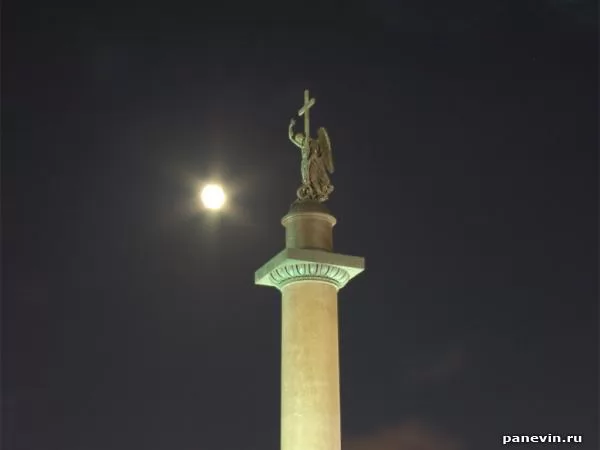
Alexander Column, a monument in honor of the victory over Napoleon. At the time of installing the pedestal of the column, Montferrand decided to play it safe: ... Due to the fact that the stone initially sat down incorrectly, it had to be moved several times, which was done with the help of only two capstans and with particular ease, of course, thanks to the soap, which I ordered to be mixed into the solution. "
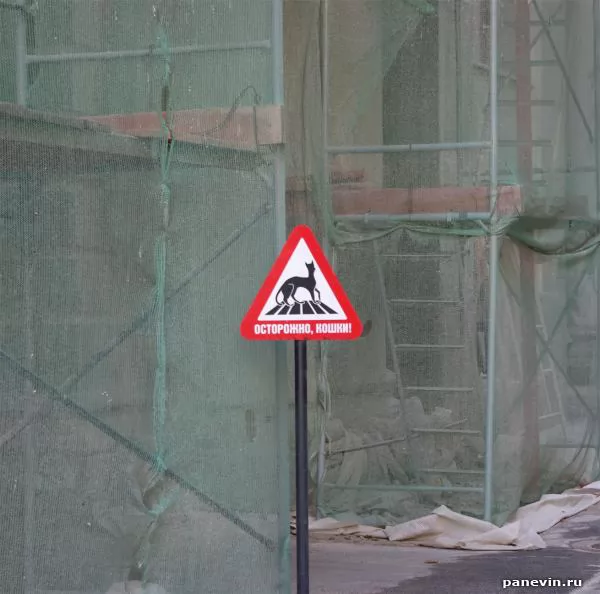
Let's wrap ourselves in the courtyard of the Hermitage and come across such signs. These signs are for drivers, so that they are more attentive and do not crush any mustache, of which there are several hundred in the Hermitage. Rats and mice are the scourge of museums, so, since the time of Elizaveta Petrovna, the staff of the museum includes woolen ones (but no one knows exactly how many of them). At the beginning of September, the “Hermitage Cat Day” is held, and anyone who wishes can get a unique kitten.
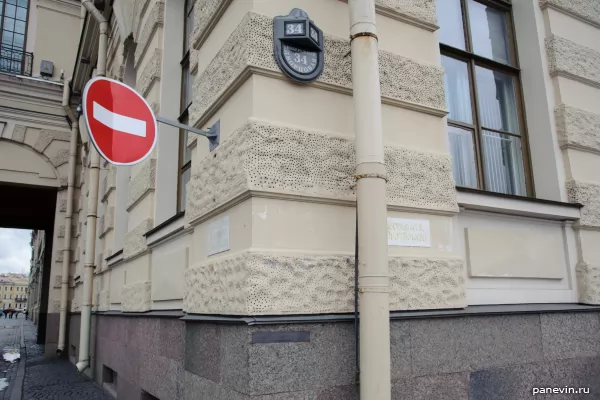
If you walk along the Winter Canal to the Palace Embankment, you will see the first street sign in St. Petersburg at the corner of the Big (Old) Hermitage. Catherine II ordered to place such at the beginning and at the end of the streets, so that it would be easier for cabbies to navigate in the city.
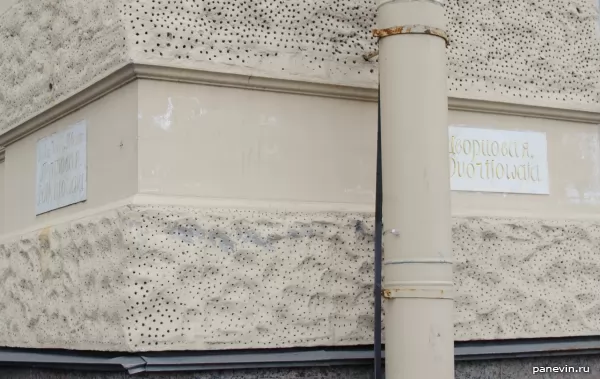
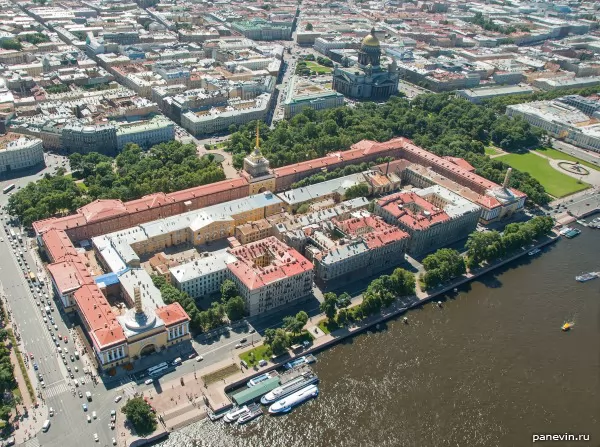
The Admiralty was originally conceived not only as a shipyard, but also as a fortress; it was surrounded by redoubts, ramparts and canals along the perimeter. A reminder of the former esplanade - Alexander Garden on the south side. In the 19th century, the construction of ships in this place lost its meaning and the space inside was built up with apartment buildings, which caused indignation, because the appearance of the Admiralty suffered.
Admiralty, Winter Palace, St. Isaac's Cathedral - the fourth. Many things in St. Petersburg have been rebuilt more than once.
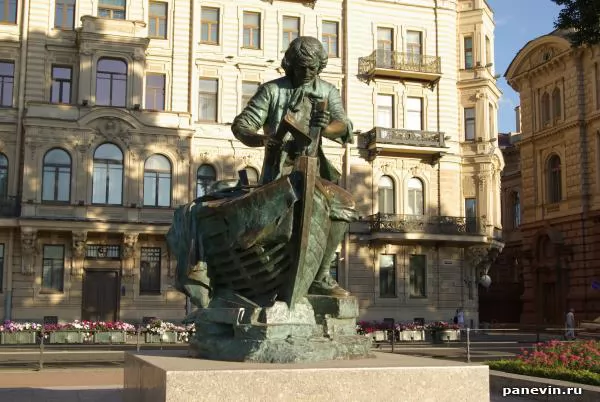
Monument to Peter I "Tsar Carpenter" - copy from copyat the Admiralty. Although the Bolsheviks destroyed this monument, a copy of it was donated by the Kingdom of the Netherlands in 1996, for which many thanks to the Dutch! Because of the October Revolution and the Civil War, the bridge had wooden railings and a wooden pavement for several years. The bridge received gratings and asphalt only in the 20s of the XX century. Peter I advocated for the inhabitants of Northern Venice to travel by boat and the Decree on the construction of the first permanent bridge across the Neva - Blagoveshchensky

Raised Palace Bridge and the Kunstkamera building at night. The construction of the Palace Bridge began in 1914, but the progress of construction was slowed down by the First World War. The bridge was nevertheless built by 1917 .
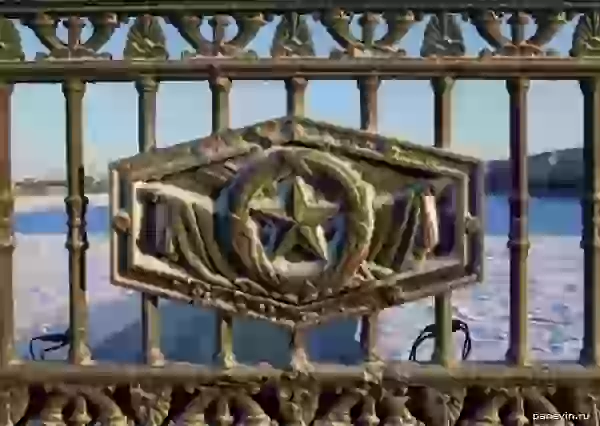
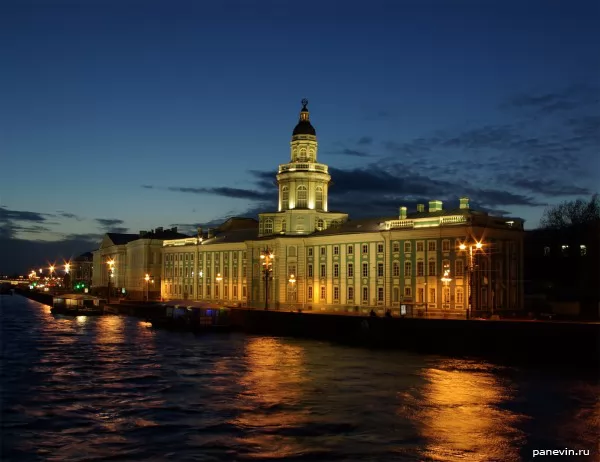
Kunstkamera - the first museum in Russia, founded by Peter I, who ordered to collect various curiosities; buy and bring values and works of art from abroad.
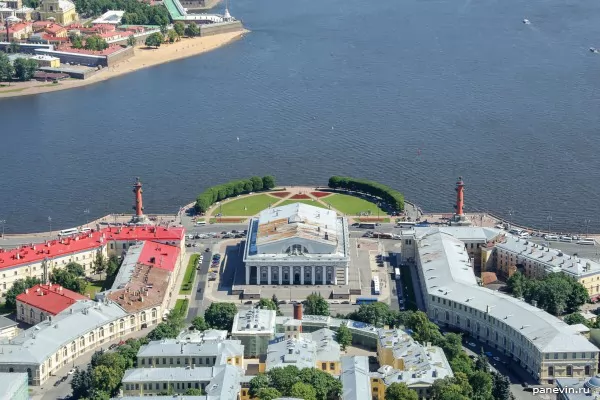
The Spit of Vasilievsky Island is considered one of the best architectural ensembles in the world. Yes, and I will correct! It received its completed appearance after the construction of the Stock Exchange building by Tom de Thomon in 1824 . A favorite place for townspeople to watch festive fireworks from the walls of the Peter and Paul Fortress, and just walks.
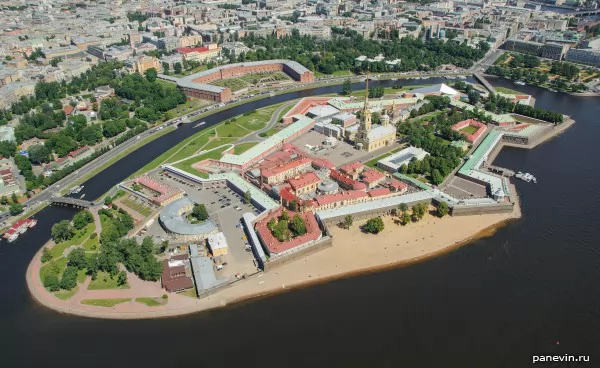
Fortress St. Petersburg - yes, the original name is exactly that, and the everyday Peter and Paul Fortress took root so much that it became the second official name (or even the first in frequency of use).
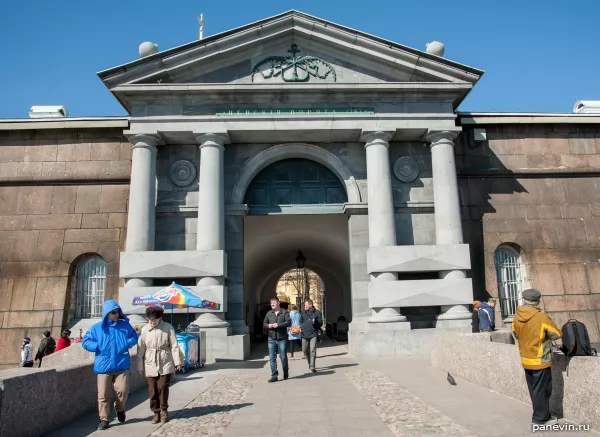
Nevsky gates .
View of the Peter and Paul Fortress from the Exchange Bridge.
One of the best fortresses of its time did not fire a single live shot, except for the fire of anti-aircraft guns during the Blockade. The horseshoe-shaped building in the shot from above is Kronverk, and from its brutal external appearance it might seem that this is a defensive structure covering the fortress from the north, but this is not so. There were indeed canals and fortifications, some of the ditches have survived to this day, but the building itself was built specifically for the artillery museum.
From the side of the Neva, the walls of the fortress are faced with granite, but this is purely for beauty, under Catherine II the embankments were ennobled with granite, so the fortress was decorated.
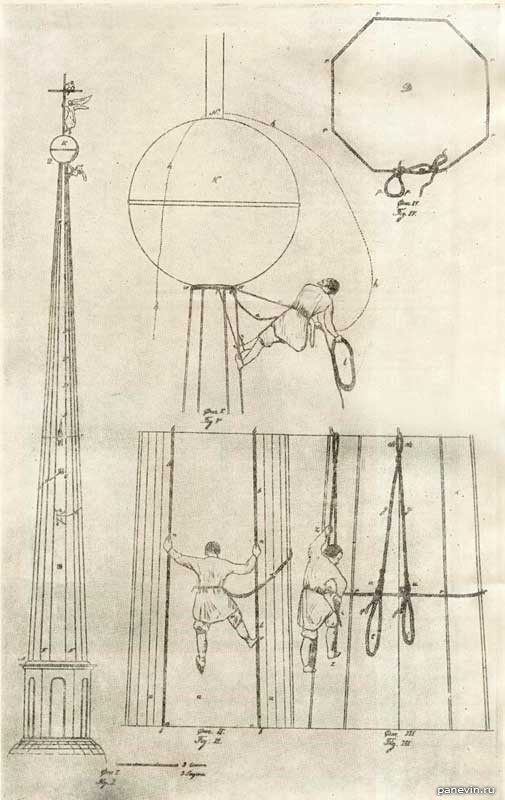
By the way, a characteristic click on the throat, Shouldn't we slap a glass? directly related to the history of St. Peter and Paul and the flood of 1777 .
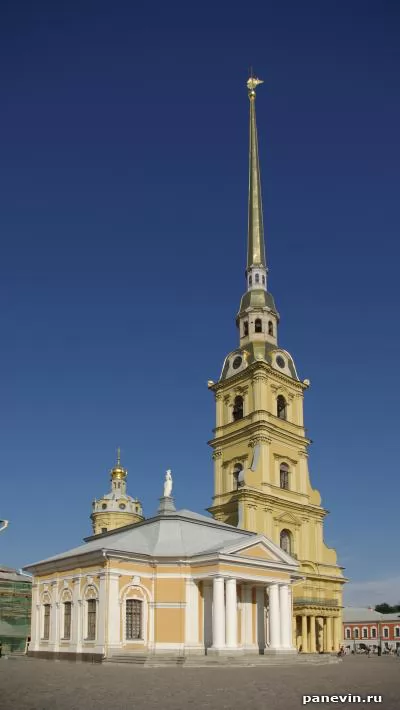
Bell tower of the Cathedral of Peter and Paul and the Botnyi house. The architecture of the cathedral is unique not only for St. Petersburg, but also for Russia in general, because more like the Lutheran cathedrals of the Baltic states. The bell tower with a height of 122 meters until 2012 was the tallest building in St. Petersburg and the most noticeable dominant.
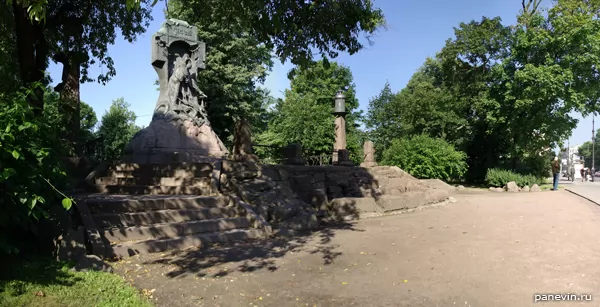
Monument to the crew of the destroyer "Guarding". A unique monument to a fantastic feat - one destroyer entered the battle against 4 Japanese destroyers and two cruisers.
The Aleksandrovsky Park, where this monument is erected, is quite interesting: the sculptural composition "Architects", the model of "Mini Petersburg" and other sculptures. Separately: Petrograd side
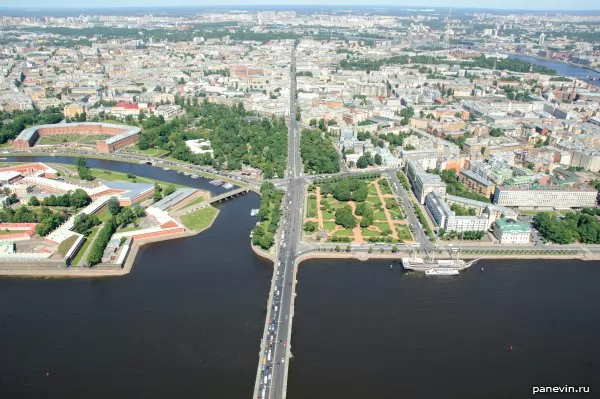
Troitsky Bridge, Kamennoostrovsky Prospect, Troitskaya Square (the first square in St. Petersburg, where the city began). On the right in the bushes hid Peter's House - the first Petersburg house, on the left - the eastern part of the Peter and Paul Fortress and Kronverk .
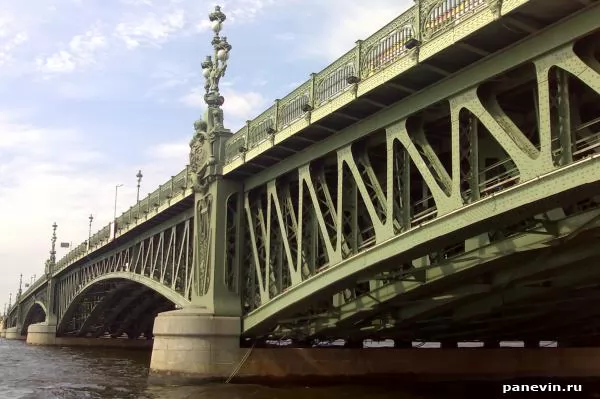
Trinity Bridge was built in 1903, in the year of the 200th anniversary of the city, the bridge became a catalyst for the development of the Petrograd side, improving transport accessibility with the central regions. In Paris, there is a twin bridge - the Alexander III bridge, but Troitsky has a second name: Three-lamp, for the design of the lanterns. The grating of the Summer Garden (architect Y. M. Felten ) is considered one of the most beautiful in the world. On the left - the Summer Garden, on the right - the barracks of the Pavlovsky regiment. Far left -
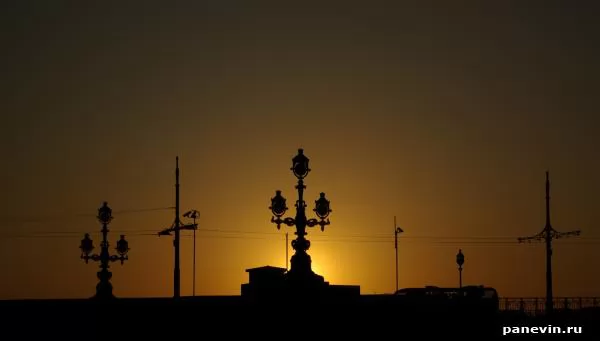
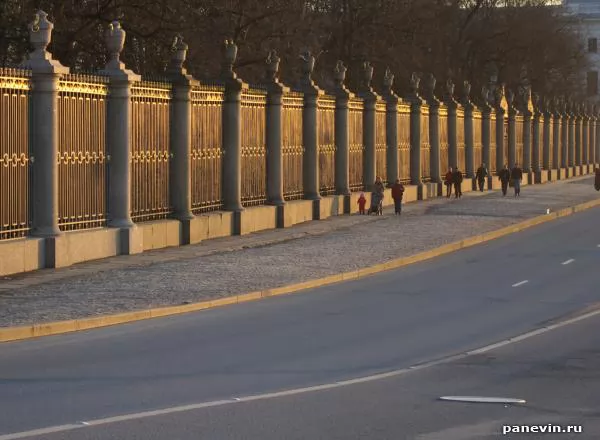
The grating of the Summer Garden (architect Y. M. Felten ) is considered one of the most beautiful in the world.
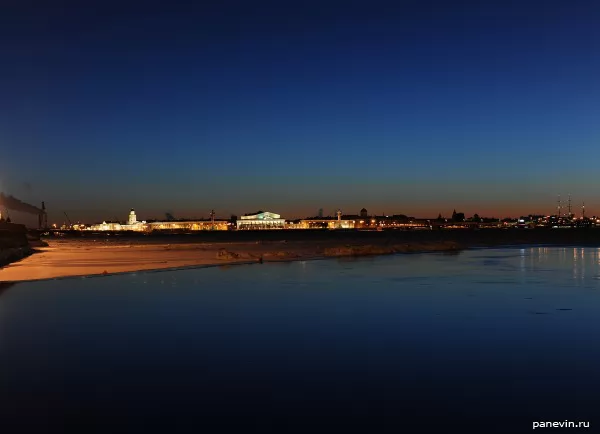
The Troitsky Bridge offers excellent views of the Palace Embankment, the Peter and Paul Fortress, the Bolshaya Neva water area, the Spit of Vasilyevsky Island and the Summer Garden .

On the left - the Summer Garden, on the right - the barracks of the Pavlovsky regiment. Far left -
Engineering castle, on the right - Savior on Spilled Blood . Well, at the beginning of the frame, from left to right: the Saltykov House, the Betsky House, the Suvorov monument, the entrance to the Troitsky Bridge .
A separate note about the Field of Mars (7 photos ). Monument to A.V.Suvorov. The illustrious commander looks like an ancient Roman warrior in spite of the fashionable trends in sculpture of that time. On a high pedestal of pink granite, a gilded bronze shield is supported, supported by figures of Glory (sc. F.G. Gordeev). (s / s. M. I. Kozlovsky, architect A. N. Voronikhin, 1801). Among the people - "a savage in a skirt."
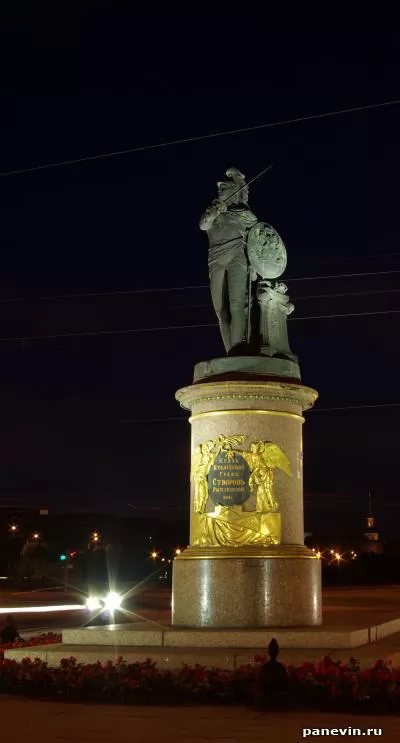
Initially, the monument to the Generalissimo was located on the Champ de Mars near the confluence of the Moika and Fontanka, but at the suggestion of Karl Rossi, was moved closer to the Neva .
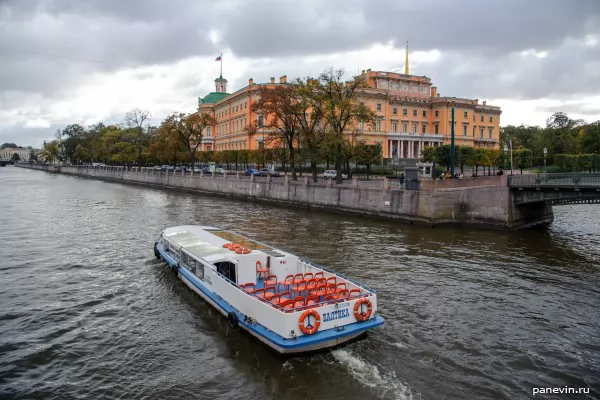
At that time, the people scoffed:
"Do not brag, sir, you are your watch parade,
Suvorov does not look, turning his back." Mikhailovsky Castle - Paul I did not want to live in the Winter Palace and ordered to build for himself a semblance of a medieval castle surrounded by moats with drawbridges. Materials for construction were withdrawn even from the construction of the third St. Isaac's Cathedral, which was completed in a simplified and slightly awkward form: naval officer Akimov wrote an epigram: "Behold, a monument of two kingdoms, both of them decent, On the marble bottom A brick top was erected"
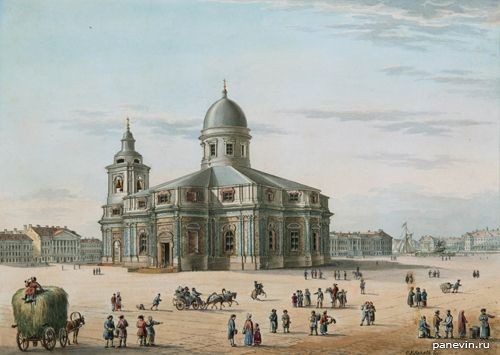
For which they cut off his tongue and exiled to Siberia. So that.
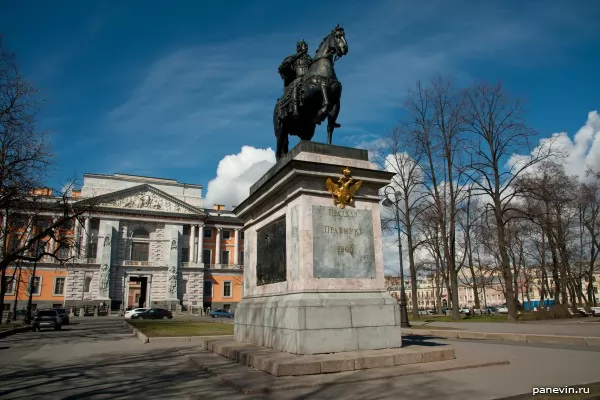
The castle received the second name Engineering after the Engineering School located there after the death of Paul I. There are many urban legends with the castle, one of them: The castle the color of the glove . Monument to Peter I in front of the Engineering Castle . Great-grandfather Great-grandson. By the way, this is the first human monument in St. Petersburg. And the only equestrian statue in the Baroque style in the city (and, perhaps, in Russia as well). Let's go back to the beginning of the route to Malaya Sadovaya:
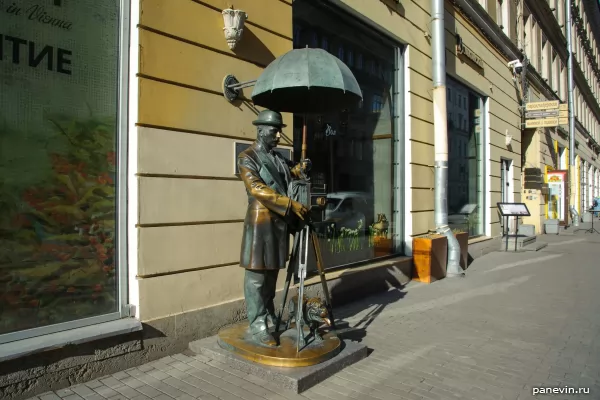
Monument to the Petersburg photographer. Installed near the house where K.K.Bulla's photographic studio was located, it served as a prototype, but the statue is not a portrait, but a collective image of St. Petersburg photographers of the late 19th - early 20th centuries. Why Sadovaya? Nobles and nobles tried to build palaces and mansions along the rivers, on which the facades went, and behind the palaces were laid out gardens and parks. Once, in the 18th century, Sadovaya Street was really green.
The route of the excursion is as follows: from Anichkov Bridge along Nevsky Prospekt to the Admiralty - Palace Square - Palace Bridge - Spit of Vasilyevsky Island - Exchange Bridge - Kronverkskaya Embankment - Peter and Paul Fortress - Troitskaya Square - Troitsky Bridge - Sadovaya Street. The route is circular and we returned to about the same place from where the walk through the center of St. Petersburg began.
Anichkov Bridge is one of the most beautiful bridges in St. Petersburg .

The first bridge across the Fontanka along Nevsky Prospect was made of wood and was built by soldiers of the battalion of Lieutenant Colonel-Engineer Mikhail Anichkov, which is why the name of the bridge came from. In 1715, Peter I ordered to build a bridge on this place, which was done by May 1716 . The first bridges at this place were drawbridge so that sailing ships could pass without folding their masts. The current three-span stone bridge was opened to traffic on November 20 1841, and in 1851 the bridge received its main decoration, which became one of the symbols of St. Petersburg - the sculptural composition "The taming of a horse by a man." 4 youths and 4 horses, which is why the people of the bridge received the comic name “The Bridge of 16 Eggs”. However, before the revolution there was a joke among the townspeople: "How many eggs are there on the Anichkov Bridge?" Because bridges have always been strategic objects, then a policeman was on duty at each, so any St. Petersburg resident answered with confidence: "eighteen!"
- A talented citizen relieves his needs in Fontanka, a policeman approaches and makes a remark.
- What, counts are allowed, but proletarians are not allowed? And he points to the bewildered law enforcement officer to the inscription on the pedestal of one of the figures: "Cast count Klodt".
Separate note: Anichkov bridge...
Nameless Erik began to be called Fontanka, probably because of the fountains of the Summer Garden, destroyed by one of the devastating floods of the 1720s and recently restored.

Gostiny Dvor is a vivid example of classicism in a purely utilitarian building. This typical building and similar guest houses were in other parts of the city, for example, on Vasilievsky Island. It is worth noting that the first Gostiny Dvor was slightly to the right and a couple of noticeable fragments of walls remained from it - from the side of Nevsky Prospekt and from Lomonosov Street. The building of the former Duma, pay attention to the hexagonal superstructure above the tower - this is an optical telegraph. Some of the ones I know of have survived at the Winter Palace and on the building of the Technological Institute. In the 1820s and 1830s, optical telegraph stations connected the capital with the suburbs and built a line to Warsaw. Since the 1850s, the need for an optical telegraph has disappeared, after the invention of the electric one. Nevsky Prospect


Nevsky Prospect - the main transport artery of St. Petersburg. Nevsky after Vosstaniya square turns a little and this part is still called Staro-Nevsky by the townspeople. The name of the avenue has no direct relation to the Neva, Nevsky is named after the Alexander Nevsky Lavra, and that, in turn, is nicknamed Alexander Nevsky. Those. there is a connection with the Neva, but it is not direct.

The house of the Singer company, one of the most notable buildings on Nevsky Prospect. But now tourists leaving the metro to the embankment of the Griboyedov Canal first of all take pictures of the building with an attractive turret, and at the time of construction the townspeople were outraged that modernity and eclecticism does not fit into the surrounding buildings. The presence of a turret indicates that the city had high-rise regulations ( Nicholas I issued a decree according to which it was impossible to build higher than the Winter Palace ), but the customer really wanted to stand out from the rest of the buildings and the architect designed such a turret. The Bolsheviks, as part of the fight against two-headed eagles on the facades of buildings, did not understand birds very much and destroyed the American coat of arms on this building. The bald eagle was restored only in the 90s. Before the revolution, the
Griboyedov Canal was the Catherine Canal, and before the foundation of the city it was the Krivusha River.

Kazan Cathedral - Voronikhin's architectural masterpiece... The fact is that according to the canons of the construction of Orthodox churches, the cathedral stands sideways to Nevsky Prospekt, but due to the colonnade, it seems that the cathedral is facing the avenue. The completion of construction coincided with the end of the war of 1812 and the cathedral became a pantheon of war heroes, trophy French banners were placed here and Field Marshal Kutuzov was buried . In front of the cathedral there are bronze sculptures of Kutuzov and Barclay de Tolly. If you look from Kutuzov towards Barclay, the scroll in the general's hand looks like a phallus. As if the commanders want "in a small way," and Kutuzov with a scroll indicates where the nearest tavern with a toilet was.

But seriously, there is a legend that the Leningraders believed that as long as the commanders stood intact, the city would not be taken. Unlike the Bronze Horseman and the monument to Lenin at the Finlyandsky railway station, these monuments were not hidden during the blockade (like the monument to Suvorov at the Troitsky bridge ). Monument to Catherine II on Ostrovsky Square. Where is such a lady, Behind which is the drama, On the Left is enlightenment, On the Right is entertainment, And in the front is not available to everyone? Behind the monument is a drama theater, on the left is the Public Library, on the right is the Rest Garden, and in front is the Eliseevsky store, the prices of goods in which at all times were not available to everyone.

Catherine II on Ostrovsky Square.

On Malaya Sadovaya Street, there are two remarkable monuments - Siberian and Ural cats, which were transferred by echelons to besieged Leningrad by order of the Supreme Command Headquarters. Two small monuments are dedicated to these cats - the cat Arseny and the cat Vasilisa.
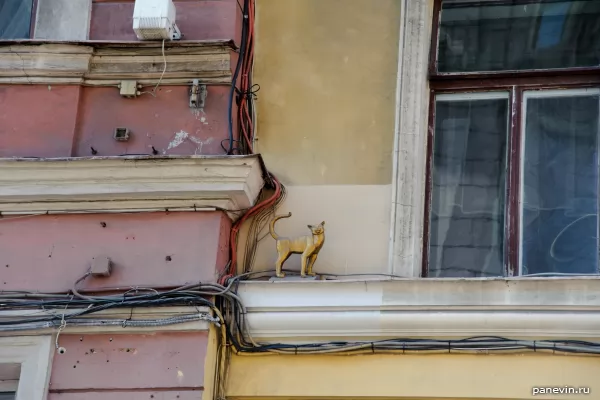

Palace Square - the Winter Palace (architect FB Rastrelli ), the General Staff Building (architect K. I. Rossi), the Alexander Column (architect O. Montferrand ), one of the most beautiful architectural ensembles in the world. The square received its completed appearance after the construction of the General Staff building and the installation of the Alexander Column. “Since the work was carried out in the winter, I ordered to mix cement with vodka and add a tenth of soap


Alexander Column, a monument in honor of the victory over Napoleon. At the time of installing the pedestal of the column, Montferrand decided to play it safe: ... Due to the fact that the stone initially sat down incorrectly, it had to be moved several times, which was done with the help of only two capstans and with particular ease, of course, thanks to the soap, which I ordered to be mixed into the solution. "

Let's wrap ourselves in the courtyard of the Hermitage and come across such signs. These signs are for drivers, so that they are more attentive and do not crush any mustache, of which there are several hundred in the Hermitage. Rats and mice are the scourge of museums, so, since the time of Elizaveta Petrovna, the staff of the museum includes woolen ones (but no one knows exactly how many of them). At the beginning of September, the “Hermitage Cat Day” is held, and anyone who wishes can get a unique kitten.

If you walk along the Winter Canal to the Palace Embankment, you will see the first street sign in St. Petersburg at the corner of the Big (Old) Hermitage. Catherine II ordered to place such at the beginning and at the end of the streets, so that it would be easier for cabbies to navigate in the city.


The Admiralty was originally conceived not only as a shipyard, but also as a fortress; it was surrounded by redoubts, ramparts and canals along the perimeter. A reminder of the former esplanade - Alexander Garden on the south side. In the 19th century, the construction of ships in this place lost its meaning and the space inside was built up with apartment buildings, which caused indignation, because the appearance of the Admiralty suffered.
Admiralty, Winter Palace, St. Isaac's Cathedral - the fourth. Many things in St. Petersburg have been rebuilt more than once.

Monument to Peter I "Tsar Carpenter" - copy from copyat the Admiralty. Although the Bolsheviks destroyed this monument, a copy of it was donated by the Kingdom of the Netherlands in 1996, for which many thanks to the Dutch! Because of the October Revolution and the Civil War, the bridge had wooden railings and a wooden pavement for several years. The bridge received gratings and asphalt only in the 20s of the XX century. Peter I advocated for the inhabitants of Northern Venice to travel by boat and the Decree on the construction of the first permanent bridge across the Neva - Blagoveshchensky

Raised Palace Bridge and the Kunstkamera building at night. The construction of the Palace Bridge began in 1914, but the progress of construction was slowed down by the First World War. The bridge was nevertheless built by 1917 .
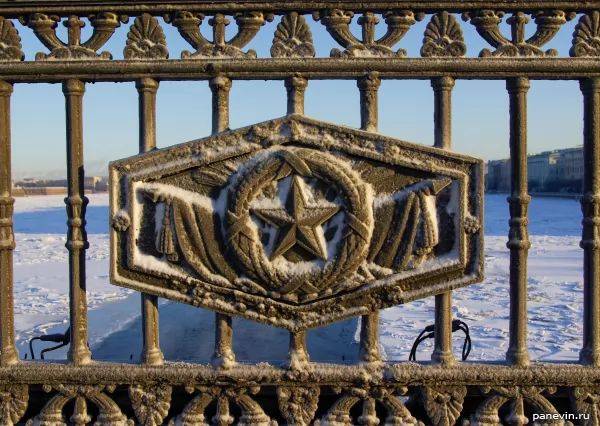

Kunstkamera - the first museum in Russia, founded by Peter I, who ordered to collect various curiosities; buy and bring values and works of art from abroad.

The Spit of Vasilievsky Island is considered one of the best architectural ensembles in the world. Yes, and I will correct! It received its completed appearance after the construction of the Stock Exchange building by Tom de Thomon in 1824 . A favorite place for townspeople to watch festive fireworks from the walls of the Peter and Paul Fortress, and just walks.

Fortress St. Petersburg - yes, the original name is exactly that, and the everyday Peter and Paul Fortress took root so much that it became the second official name (or even the first in frequency of use).

Nevsky gates .

View of the Peter and Paul Fortress from the Exchange Bridge.
One of the best fortresses of its time did not fire a single live shot, except for the fire of anti-aircraft guns during the Blockade. The horseshoe-shaped building in the shot from above is Kronverk, and from its brutal external appearance it might seem that this is a defensive structure covering the fortress from the north, but this is not so. There were indeed canals and fortifications, some of the ditches have survived to this day, but the building itself was built specifically for the artillery museum.
From the side of the Neva, the walls of the fortress are faced with granite, but this is purely for beauty, under Catherine II the embankments were ennobled with granite, so the fortress was decorated.

By the way, a characteristic click on the throat, Shouldn't we slap a glass? directly related to the history of St. Peter and Paul and the flood of 1777 .

Bell tower of the Cathedral of Peter and Paul and the Botnyi house. The architecture of the cathedral is unique not only for St. Petersburg, but also for Russia in general, because more like the Lutheran cathedrals of the Baltic states. The bell tower with a height of 122 meters until 2012 was the tallest building in St. Petersburg and the most noticeable dominant.

Monument to the crew of the destroyer "Guarding". A unique monument to a fantastic feat - one destroyer entered the battle against 4 Japanese destroyers and two cruisers.
The Aleksandrovsky Park, where this monument is erected, is quite interesting: the sculptural composition "Architects", the model of "Mini Petersburg" and other sculptures. Separately: Petrograd side

Troitsky Bridge, Kamennoostrovsky Prospect, Troitskaya Square (the first square in St. Petersburg, where the city began). On the right in the bushes hid Peter's House - the first Petersburg house, on the left - the eastern part of the Peter and Paul Fortress and Kronverk .

Trinity Bridge was built in 1903, in the year of the 200th anniversary of the city, the bridge became a catalyst for the development of the Petrograd side, improving transport accessibility with the central regions. In Paris, there is a twin bridge - the Alexander III bridge, but Troitsky has a second name: Three-lamp, for the design of the lanterns. The grating of the Summer Garden (architect Y. M. Felten ) is considered one of the most beautiful in the world. On the left - the Summer Garden, on the right - the barracks of the Pavlovsky regiment. Far left -


The grating of the Summer Garden (architect Y. M. Felten ) is considered one of the most beautiful in the world.

The Troitsky Bridge offers excellent views of the Palace Embankment, the Peter and Paul Fortress, the Bolshaya Neva water area, the Spit of Vasilyevsky Island and the Summer Garden .

On the left - the Summer Garden, on the right - the barracks of the Pavlovsky regiment. Far left -
Engineering castle, on the right - Savior on Spilled Blood . Well, at the beginning of the frame, from left to right: the Saltykov House, the Betsky House, the Suvorov monument, the entrance to the Troitsky Bridge .
A separate note about the Field of Mars (7 photos ). Monument to A.V.Suvorov. The illustrious commander looks like an ancient Roman warrior in spite of the fashionable trends in sculpture of that time. On a high pedestal of pink granite, a gilded bronze shield is supported, supported by figures of Glory (sc. F.G. Gordeev). (s / s. M. I. Kozlovsky, architect A. N. Voronikhin, 1801). Among the people - "a savage in a skirt."

Initially, the monument to the Generalissimo was located on the Champ de Mars near the confluence of the Moika and Fontanka, but at the suggestion of Karl Rossi, was moved closer to the Neva .

At that time, the people scoffed:
"Do not brag, sir, you are your watch parade,
Suvorov does not look, turning his back." Mikhailovsky Castle - Paul I did not want to live in the Winter Palace and ordered to build for himself a semblance of a medieval castle surrounded by moats with drawbridges. Materials for construction were withdrawn even from the construction of the third St. Isaac's Cathedral, which was completed in a simplified and slightly awkward form: naval officer Akimov wrote an epigram: "Behold, a monument of two kingdoms, both of them decent, On the marble bottom A brick top was erected"

For which they cut off his tongue and exiled to Siberia. So that.

The castle received the second name Engineering after the Engineering School located there after the death of Paul I. There are many urban legends with the castle, one of them: The castle the color of the glove . Monument to Peter I in front of the Engineering Castle . Great-grandfather Great-grandson. By the way, this is the first human monument in St. Petersburg. And the only equestrian statue in the Baroque style in the city (and, perhaps, in Russia as well). Let's go back to the beginning of the route to Malaya Sadovaya:

Monument to the Petersburg photographer. Installed near the house where K.K.Bulla's photographic studio was located, it served as a prototype, but the statue is not a portrait, but a collective image of St. Petersburg photographers of the late 19th - early 20th centuries. Why Sadovaya? Nobles and nobles tried to build palaces and mansions along the rivers, on which the facades went, and behind the palaces were laid out gardens and parks. Once, in the 18th century, Sadovaya Street was really green.
The route of the excursion is as follows: from Anichkov Bridge along Nevsky Prospekt to the Admiralty - Palace Square - Palace Bridge - Spit of Vasilyevsky Island - Exchange Bridge - Kronverkskaya Embankment - Peter and Paul Fortress - Troitskaya Square - Troitsky Bridge - Sadovaya Street. The route is circular and we returned to about the same place from where the walk through the center of St. Petersburg began.
Share:
Themes: attractions 134 photos 417 St.-Petersburg 119
Ticket sales through JetRadar.com service without commissions and markups.
← Blog
virtualnaya_obzornaya_ekskursiya_po
blog

